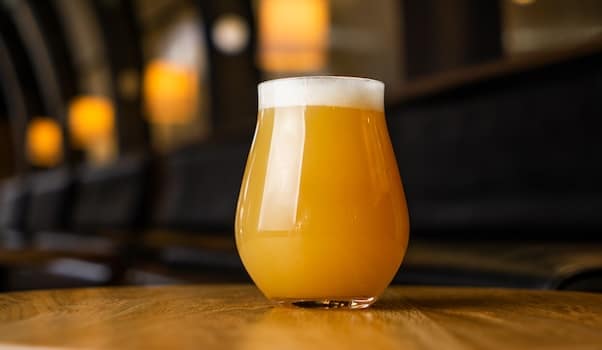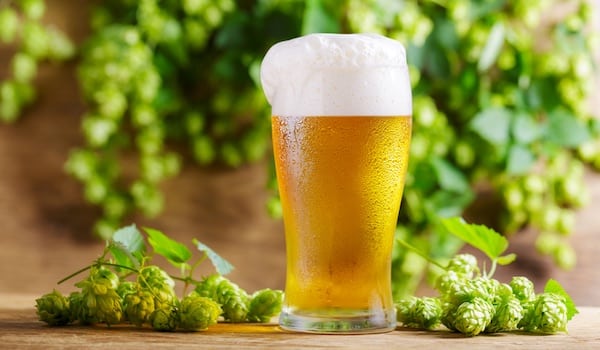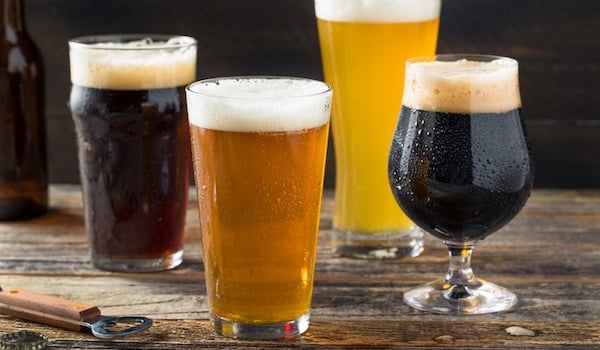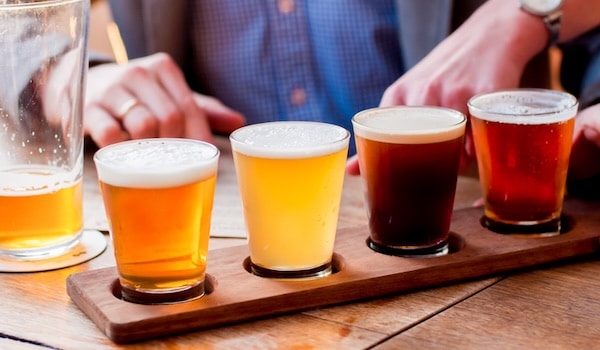
In This Article
- Introduction
- A Brief History of Beer Taste
- Common Flavor Families in Beer
- How to Taste a Beer
- Beginner-Friendly Styles to Try
- Conclusion
- Sign Up for Our Newsletter
Introduction
If your first sip of beer ever made you squint and think, “Wow, that’s bitter,” you’re in good company. But bitterness is only one piece of the puzzle. Beer can be crisp and clean, rich and chocolatey, fruity and spicy, or sour. It’s one of the most versatile drinks in the world—and that’s exactly why it can feel overwhelming when you’re staring at a bar menu full of unfamiliar names.
Here’s the good news: every beer style follows some general characteristics. Once you know the major flavor families, you can get a sense of what your pint will taste like before you even order it.
Related Post:
A Brief History of Beer Taste
Beer hasn’t always tasted the way it does today. Ancient ales from Mesopotamia and Egypt were often thick, sweet, and unhopped—closer to porridge than the beverages we drink now. Hops entered the brewing picture in medieval Europe, adding bitterness and acting as a preservative. From there, styles diverged: English ales leaned malty and fruity, German brewers perfected crisp lagers, and Belgian monks cultivated spicy, yeast-driven beers.
Fast-forward to today, and the craft beer boom has blown the doors wide open. Brewers experiment with fruit, chocolate, coffee, lactose, herbs, and barrels, creating flavors that go far beyond “just bitter.”
Common Flavor Families in Beer
Most beers fit into one of five broad flavor families. Knowing these categories makes it much easier to navigate a crowded tap list.
Malty and Sweet
Malty beers showcase the grain side of brewing. They lean smooth and slightly sweet, with rich notes of caramel, toffee, biscuit, and sometimes chocolate. Darker versions can even hint at roasted coffee.
- Examples: Amber Ale, American Brown Ale, Bocks
- Flavor Profile: Toasted bread, roasted caramel, chocolate
- Pair It With: Barbecue ribs, roasted chicken, or grilled vegetables
Bitter and Hoppy
Hop-forward beers are bold and aromatic. While bitterness is their calling card, hops also contribute citrus, pine, resin, and tropical fruit notes depending on the variety. This family defines modern American craft beer.
- Examples: American Pale Ale, IPA, Double IPA
- Flavor Profile: Grapefruit, pine needles, mango, passionfruit
- Pair It With: Burgers, sharp cheddar, spicy tacos
Fruity and Spicy
Certain yeast strains create esters and phenols that taste like banana, clove, pepper, or orange zest. These beers are usually hazy or golden in color, light to medium in body, and approachable for drinkers who enjoy complexity without overwhelming bitterness.
- Examples: Belgian Ale, Hefeweizen, Saison
- Flavor Profile: Banana, clove, pepper, citrus
- Pair It With: Roast chicken, fish, fresh salads, or omelets at brunch
Sour and Tart
Sour beers get their zing from wild yeast or bacteria that create lactic acid during fermentation. They can be lightly tart and refreshing or bracingly sour and funky. Many are brewed with fruit for balance, which makes them surprisingly easy to drink.
- Examples: Gose, Lambic, Berliner Weisse, American Sour Ale
- Flavor Profile: Lemon, vinegar, funk, berries
- Pair It With: Funky cheese, creamy pasta, or fruit desserts
Roasty and Dark
Dark beers use roasted malts to deliver bold, full-bodied flavors that often remind you of espresso, cocoa, or burnt toast. These are sipping beers that shine on cool nights or after a big meal.
- Examples: Porter, Stout, Schwarzbier
- Flavor Profile: Coffee, dark chocolate, smoke, roasted bread
- Pair It With: Beef stew, roasted lamb, or a chocolate torte
Beer Flavor Families at a Glance
| Flavor Family | Common Descriptors | Example Styles | Good Food Pairings |
|---|---|---|---|
| Malty & Sweet | Caramel, toffee, biscuit, chocolate | Amber Ale, Brown Ale | Barbecue, roasted meats |
| Bitter & Hoppy | Grapefruit, pine, tropical fruit | Pale Ale, IPA | Burgers, spicy foods |
| Fruity & Spicy | Banana, clove, pepper, citrus | Hefeweizen, Belgian Ale | Chicken, salads, brunch |
| Sour & Tart | Lemon, vinegar, funk, berries | Gose, Lambic | Funky cheese, creamy pasta |
| Roasty & Dark | Coffee, cocoa, smoke, bread | Porter, Stout | Stews, roasts, desserts |
How to Taste a Beer
Drinking beer and tasting beer aren’t quite the same thing. To really understand what’s in the glass, slow down and engage all your senses.
- Look – Notice the color, clarity, and head. A hazy IPA looks very different from a pale lager.
- Smell – Swirl gently and sniff. Aroma sets the stage for flavor, and hops especially shine here.
- Sip – Let it sit on your tongue. Pay attention to sweetness, bitterness, acidity, and balance.
- Mouthfeel – Is it crisp and bubbly, smooth and creamy, or heavy and dry?
- Aftertaste – Notice how long flavors linger. Some beers finish clean; others stick around.
Pro Tips for Better Beer Tasting
- Temperature matters. Lagers are best served cold (38–42°F), while stouts and strong ales open up at slightly warmer temps (45–55°F).
- Glassware counts. Pint glasses work for most beers, but tulip glasses help trap aroma in aromatic styles like IPAs or Belgian ales.
- Order wisely. Taste lighter beers before heavier ones, or subtle flavors will be overwhelmed.
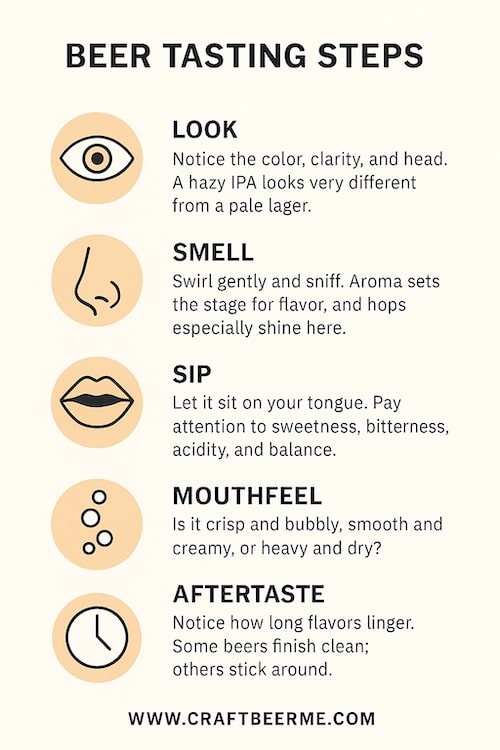
Beginner-Friendly Styles to Try
If you’re new to beer, some styles are easier to approach than others. Here are five that showcase a range of flavors without overwhelming the palate:
- American Lager – Pale yellow, crisp, and refreshing. Think Budweiser or Miller High Life. They’re subtle, familiar, and perfect for hot days.
- Hefeweizen – Cloudy and fruity, with banana and clove flavors from the yeast. Classics like Weihenstephaner or Blue Moon are smooth and approachable.
- Pale Ale – Balanced between hops and malt, offering a gentle introduction to bitterness. Sierra Nevada Pale Ale is the gold standard here.
- Milk Stout – Smooth, creamy, and slightly sweet thanks to lactose sugar. Left Hand Milk Stout is a great example that shows dark beers don’t have to be intimidating.
- Gose – Lightly tart with a touch of salt, often brewed with fruit. Anderson Valley Blood Orange Gose is a refreshing summer pick.
| Style | Famous Craft Example | Flavor Notes | Why Beginners Like It |
|---|---|---|---|
| American Lager | Brooklyn Lager (Brooklyn Brewery) | Crisp, clean, slightly malty | Approachable and balanced |
| Hefeweizen | Allagash White (Allagash Brewing) | Banana, clove, citrus | Fruity, smooth, and refreshing |
| Pale Ale | Sierra Nevada Pale Ale (Sierra Nevada Brewing) | Balanced hops + malt | Classic gateway craft beer |
| Milk Stout | Left Hand Milk Stout (Left Hand Brewing) | Chocolate, cream, mild sweetness | Dark but approachable |
| Gose | Anderson Valley Blood Orange Gose (Anderson Valley Brewing) | Lightly tart, salty, citrusy | Refreshing and unique |
Conclusion
So, how does beer taste? The real answer: it depends. Beer can be crisp and clean, rich and roasty, fruity and spicy, or lip-smackingly sour. That’s the magic of it—there’s a style for almost every flavor preference, every mood, and every meal.
The more you try, the more you’ll learn what you like. And once you’ve got the basics down, you’ll never be overwhelmed by a beer menu again.
Let’s Talk Beer!
💬 What’s your favorite beer flavor profile? Share your go-to style in the comments.
📸 Tag us on Instagram @craftbeermenow to be featured. Want more beer guides like this? Sign up for our newsletter and never miss a pour.
✉️ Sign up for our Newsletter Below

